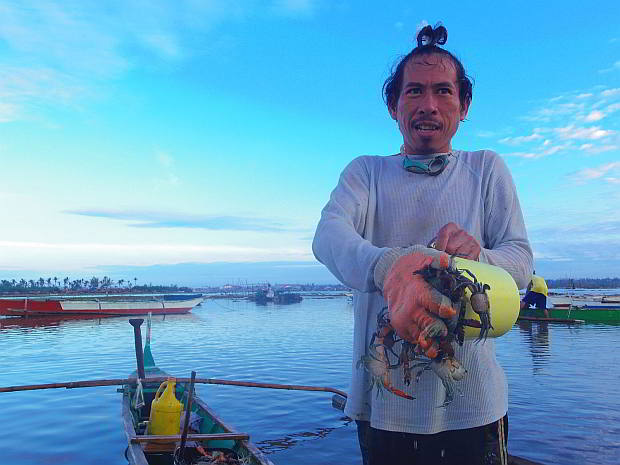
Fisherman harvest tiny crabs while waiting for his banca that is up for repair. (CDN PHOTO/ MARIAN Z. CODILLA)
I don’t know how to react, I am overwhelmed and just cried.”
This is what Lilibeth Gidukos, a wife of a fisherman and a mother of seven children said after she lost everything in the horrifying typhoon that hit Bantayan island three months ago.
With their property and livelihood lost, she was on the brink of losing her sanity when she despaired on how to provide for her family’s needs in terms of food and shelter until a group of volunteers gave them a chance at survival when they provided her family with a small fishing boat.
“Wala ko kabaw unsa ako buhaton, nitulo ra ang akong luha sa kalipay, (I don’t know what to do, I just cried for joy),” Gidukos said.
Gidukos’ family is just one of the 1,118 beneficiaries of the Back to Sea project that served 16 barangays in the three municipalities in Bantayan island.
Lilibeth Gidukos was emotional as she thank the organizers of the Back to Sea Project, Michelle Lim (left) and Allan Monreal (center) for helping her family rise again after the typhoon. (CDN PHOTO/ MARIAN Z. CODILLA)
THE FISHERMEN’S PROJECT
Back to Sea project started as a corporate social responsibility program of Bantayan Island Nature Park until they decided to make it a separate project and came up with Damgo sa Kaugmaon Inc., a nongovernment organization created very recently.
Allan Monreal, Back to Sea Project head said the idea of the project is that aside from giving them boats to start the livelihood they are really good at, the project is really to empower them to start anew, not as individuals but as a community.
“We want this to have a long term impact to the community through sustainable development and bayanihan,” Monreal who is also the president of the Bantayan Island Association of Hotel, Resorts, Bar and Restaurants and whose family owns Bantayan Island Nature Park.
Through Facebook and a bit of prodding from possible donors, they were able to raise around P1.5 million. The GMA broadcast network’s Kapuso Foundation also helped them a lot after celebrity Marian Rivera came in to support the project, said Michelle Lim, project coordinator of Back to Sea.
Since the project started a few months back, they were able to launch 625 boats to the sea. But this is dwarfed by the actual need of around 2,500 boats for the 12 barangays in Bantayan island that were initially assessed. This figure also corresponds to the number of fishing boats damaged by Yolanda.
Fishing is the major means of livelihood of the residents in Bantayan and after the supertyphoon, most if not all of them could not go back to sea after their boats were battered by gale-force winds and waves churned up by the supertyphoon.
The project aims to organize the fishing community of every barangay in Bantayan. Donations according to Monreal are pooled together. Tranches of P50,000 will be given to fishermen associations to help them build their own fishing boats or renew their seaweed (guso) production.
The cash given out will have to be liquidated by the association and regular reports need to be submitted.
Although they give out cash, it is not a dole-out as each fishermen must reimburse 50 percent of the money to the association’s coffers.
How do they do that? By empowering the fisherfolks, Monreal said.
“We taught them financial planning 101. They are stuck in a vicious cycle and returning 50 percent of the money may not be easy for them. We make them understand the value chain of a fisherman and we want them to own a value chain and allow them to earn from their own venture,” Monreal explained.
He later returned to the group of leaders of newly formed fishermen associations from different baragays gathered at the Bantayan Island Nature Park for a forum and reminded them to be financially responsible.
“You have to make some sacrifices,” Monreal said.
A fisherman docks his new baroto (fishing boat) to the shore after he went out to fish. (CDN PHOTO/ MARIAN Z. CODILLA)
A fisherman said that the project is better than borrowing money from a loan shark as the money borrowed will return to the community.
“Nagkahinay hinay na og bangon ang Bantayan. Ang uban nangutang nalang sa mga ‘bombay’ pero mas maayo ni ang Back to Sea kay bisan og mahulog na murag utang gihapon ni pero mabalik raman gihapon sa amo ang kwarta,” said a fisherman.
Half of the money lent goes back to the association which then decides which project to venture into to build better communities. Michelle Lim, project coordinator said that some associations have already thought about protecting their natural resources such as their natural caves and come up with their own eco-tourism plan.
“Things like this happen now, they were able to think that way because they are now empowered. Before they lacked the confidence to speak out but now we were pleasantly surprised with their newfound assurance,” said the 26-year-old project coordinator.
Manreal told the fisherfolks to step up and go beyond what is expected of them without sacrificing their natural resources which are their real assets.
A couple harvest their newly planted seaweeds (guso). Seaweed farming is one livelihood option while they are waiting for their boats to be repaired. (CDN PHOTO/ MARIAN Z. CODILLA)
“We want to build-up sustainability and bayanihan thus there must be transparency and accountability,” Lim added.
Some barangays now received six tranches of financial assistance. An association can receive more funding if they can present their liquidation reports and come up with a feasible proposal for their community.